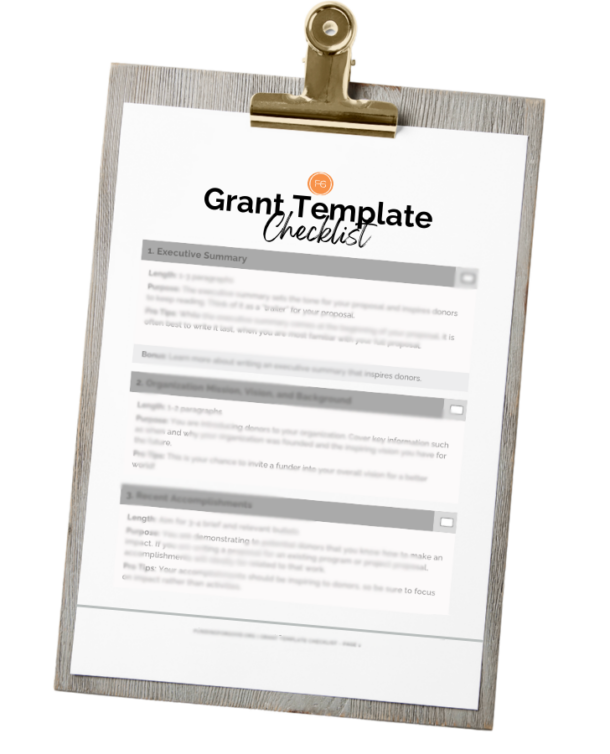Here at Funding for Good, our team has decades of experience writing grants. Combined, we’ve written hundreds (maybe thousands) of grant proposals and raised hundreds of millions of dollars. And along the way, we’ve learned a lot of lessons about grant writing.
So today, I thought I’d gather a few of the top grant writing tips our team learned the hard way (so you don’t have to).
My Top 8 Grant Writing Tips
1. Follow Directions
Many years ago, a wise manager shared this nugget of wisdom:
When it comes to grant writing, no matter what, always follow directions.
It sounds simple, but you would not believe how many organizations really don’t follow directions. In fact, I’ve seen grants that were already scheduled to be approved get turned down simply because an organization couldn’t be bothered to read and follow the instructions.
When you’re reviewing grant proposal guidelines or an RFP, here are some key instructions to look out for (and follow!):
- Deadline (Always meet the deadline unless you have an advance conversation with your program officer.)
- Length (Length requirements may be expressed as pages, word counts, or even character counts)
- Formatting (Some funders really do want a proposal that is double-spaced with 12-point font and 1” margins. If they ask for it, do it!)
- Required questions (Yes, you need to answer all of them.)
- Required attachments (You should have most required attachments, like budgets and staff lists, at the ready.)
- Funder’s stated priorities for the RFP (Make sure your proposal speaks to these priorities.)
- Language and terminology preferences (For example, in the RFP or other materials, does a funder say “zero emission vehicles,” “electric vehicles,” or “clean cars and trucks”? They might all mean the same thing to you, but if a funder is using a specific term, assume they are doing so for a reason.)
2. Strong Programs = Strong Grants
The first words you write about a program should NOT be your grant proposal (though it often is).
Great grant proposals start with great program or project plans. These plans can take the form of memos, workplans, timelines, or even well-organized spreadsheets. The key is that, ideally, you should know your goals and objectives and how you intend to achieve them—BEFORE you start writing a grant.
Of course, as anyone in nonprofit fundraising will tell you, grants can often be the motivation to get busy program staff to sit down and put their plans in writing. Even if that is the case, the same process should hold true.
Start the grant writing process by focusing on outlining a strong and viable program or project—and then craft it into a compelling proposal narrative.
This is especially critical to avoid going after problematic project grants that can ultimately cost your organization time and money.
3. When You Write a Grant, You’re Telling a Story
Grant writing is all about storytelling.
You are telling a well-researched story about real and compelling community needs. And then, you’re inspiring potential donors with your plans to address those needs.
From your opening sentence to your final proposal conclusion, every single word in your proposal should help tell this story.
Now, sometimes, funders aren’t thinking of grant proposals as stories. Program officers may be thinking about the metrics they’re going to show their board to prove their grantmaking is having an impact. Foundations may ask you for theories of change and logic models and the numbers of people served. They may require you fill out multiple charts using pre-set templates.
And yes, you need to answer all of those questions. You need to complete every chart and fill in every budget worksheet.
But you can’t just go through the motions. You need to make sure all those pieces are still telling the same compelling story about your community’s need and your plan to solve it. For example, something as simple as the line-item descriptions in your project budget can tell a story. Do you write “program staff salaries” or do you write “community outreach team”?
The key is to start with the story and then figure out how the answer to each question can help you best tell that story. That’s where creating a strong boilerplate grant proposal can make the difference between funding success and funding failure.
4. Boilerplate Grant Proposals Will Help You Raise More Money
Not every grant proposal is written for a funder. In fact, the most valuable grant proposals are what we call boilerplate proposals or grant proposal templates.
These comprehensive proposals include the answers to 99% of the questions funders will ask you. For example, depending on the type of proposal, common elements might include:
- Brief proposal summary (or executive summary)
- Statement of need
- Organizational mission, background, and qualifications
- Goals and objectives
- Strategies and activities
- Timeline
- Evaluation plan
- Budget
- Key staff
- Conclusion
Once you have your proposal template ready, all you have to do is adapt it for new funders and RFPs. This saves you from having to reinvent the wheel for every grant request. This saves time and money. But more importantly, it means every grant proposal you submit is built on the strongest foundation possible. A strong proposal will increase the likelihood of receiving funding.
5. Keep Your Grant Attachments at the Ready
Grant attachments—from 990s to budgets to board lists—should be the EASIEST part of the grant writing and submission process. But too often, fundraisers end up scrambling to pull this information together at the last minute.
To keep it simple, create a folder called GRANT ATTACHMENTS in a shared drive. Drop in the current copies of all standard grant attachments, such as your organization’s:
- IRS form 990s for the past two years
- Audits for the past two years
- Current year operating budget
- Most recent budget to actuals
- Board of directors list (with affiliations)
- By-laws
- Diversity, equity, and inclusion statements
Whenever a new audit is completed or a new board member joins, simply update the file in your GRANT ATTACHMENTS folder. Then, everything will be at the ready for your next grant submission.
6. Grant Proposals Don’t Have to Be Poetry, But They Should Be Proofread
Up in tip 3, I said grant writing is all about storytelling. But that doesn’t mean your prose has to be worthy of a Nobel prize. In fact, whether you’re writing a novel or a grant proposal, story rules above all else.
Just make sure your writing is clear with minimal typos or grammatic errors. That way, your organization’s story can shine. If you’re not a great proofreader, you can invest in a tool like Grammarly and make sure someone on the team does a final proofread.
7. Invest in Smart Training
None of us are born grant writers. It takes training, skills-building, and plenty of practice. Luckily, there are many amazing trainings out there to help you and your team jumpstart your grant writing skills.
Funding for Good offers two affordable on-demand training programs, including our Grant Writing Training Series and our Fundraising Fundamentals Training Series.
8. Outsourcing to Grant Experts Really Is Worth It: Here’s Why
When I was a development director, I was hesitant to outsource grant writing. As a staff fundraiser, your job is to raise money, not spend it!
But as a nonprofit consultant, I’ve experienced firsthand the power of outsourcing fundraising activities like grant writing.
Imagine this all-too-common scenario:
You have a new program that an existing funder wants to fund. It will take at least 20 hours at the computer to transform your program plan into a compelling new grant proposal tailored to this funder. BUT you also have a list of 20 mid-level donors you need to cultivate to meet your year-end fundraising goals.
Which is a better use of your time: Drafting yet another grant proposal or serving as an organizational representative to build lasting and sustainable donor relationships?
The benefit of outsourcing grant writing to a professional is that you don’t have to choose! You can accomplish both at the same time. If you’re wondering how much it costs to hire a top grant pro, check out our comprehensive grant writing fee guide.


